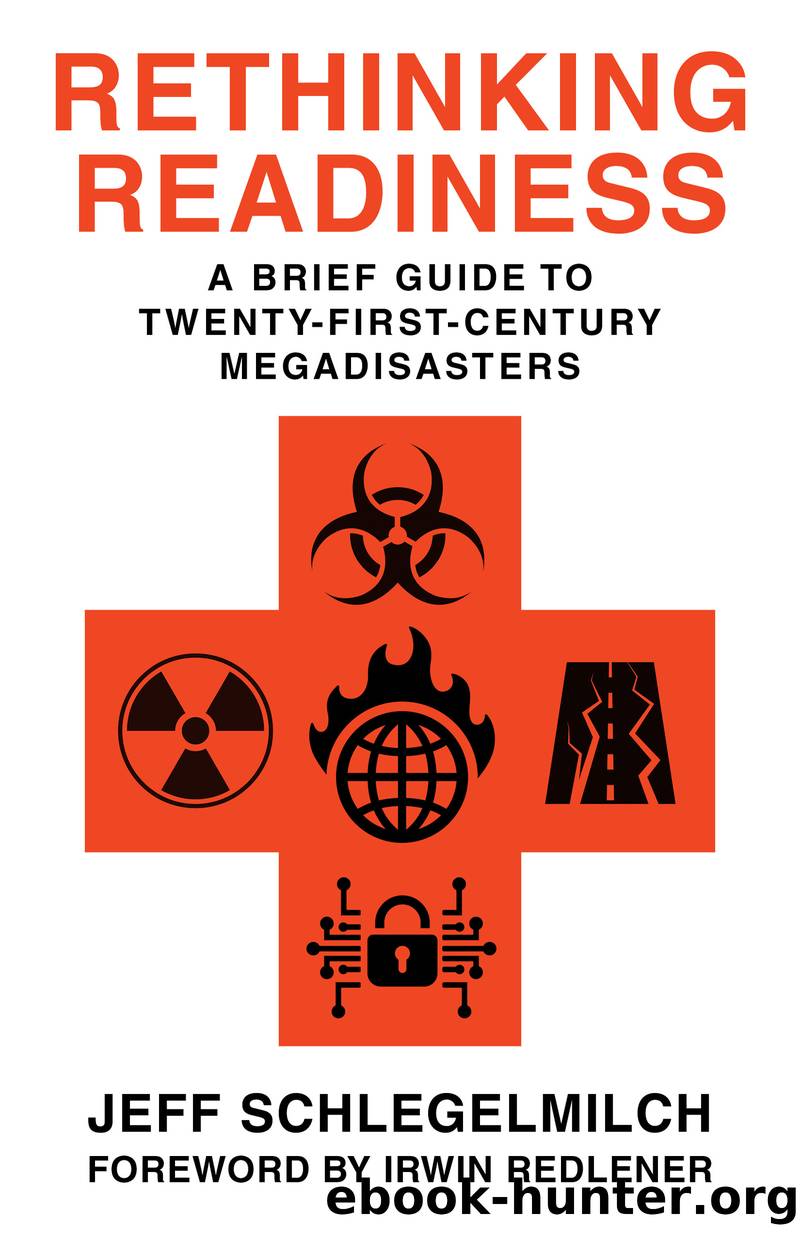Rethinking Readiness by Jeffrey Schlegelmilch

Author:Jeffrey Schlegelmilch
Language: eng
Format: epub
Publisher: Columbia University Press
EVERYBODY OWNS PART, NOBODY OWNS ALL
Disasters are responded to by those immediately impacted, as well as agencies and organizations outside of the impacted area. The effects are also felt by people on the individual level and on economies at the community, national, and even international levels. The work of disaster response is similarly distributed across agencies, companies, nonprofits, and the impacted individuals themselves. And while some collaborations are lauded, such as public-private partnerships, in practice these are usually simple contractual relationships, rather than true partnerships, in which intellectual and material resources are shared to better the response and recovery efforts.20 In fact, when new actors come together in disasters for the first time, it can initially reduce operational efficacy due to cross-cultural differences in approaches, inconsistent priorities, and variable operational contexts.21
When disasters strike, the response and recovery are also paid for by a myriad of funders. In broad categories, catastrophes are paid for with tax dollars, private markets (e.g., insurance and reinsurance), and charitable contributions. When funding is not available, the costs are absorbed as economic loss. Each of these categories has several subcategories, and each has advantages and disadvantages; as such, none is a complete solution on its own.22 However, there is no single overseer across the financiers of disaster response. This leaves market forces to define private sector modes of financing, political processes to define public payments, the attention of the populace to feed charitable donations, and the strength of economies to deal with the rest.
Our systems of governance do not favor broad perspectives across preparedness challenges either. Although national guidance documents and grant programs are designed to create a cohesive national set of capabilities, the structure of federalism in the United States places most of the responsibility and authority at the state and local levels of government. Even national legislators are responsible first to their districts that elect them, creating wide variations in funding based on representation on key congressional committees rather than a more thorough calculation of the national interest.23 As a result, the kind of centralized national leadership that is often demanded by local and community-based actors is not only difficult to achieve but is not congruent with the design of a free-market federalist democracy.
Even with voters providing the ultimate accountability in a democracy, short-term incentives often supersede long-term sustainability. It is well established that preparedness investments save many times more than the cost of unmitigated disasters.24 In other words, it is far more efficient and ultimately less costly to invest in prevention or resiliency than to pay for the response and damage caused by any large-scale disaster. But voters—and politicians—tend not to respond to this thinking. To the contrary, voters overwhelmingly reward elected officials who bring in substantial disaster relief, whereas investments in disaster preparedness seem to have little if any impact on voter behavior.25 While the overarching value of preparedness and mitigation is well understood, translating that into the behaviors of individuals, businesses, and politicians has not been achieved. And so we find
Download
This site does not store any files on its server. We only index and link to content provided by other sites. Please contact the content providers to delete copyright contents if any and email us, we'll remove relevant links or contents immediately.
When Breath Becomes Air by Paul Kalanithi(7254)
Why We Sleep: Unlocking the Power of Sleep and Dreams by Matthew Walker(5637)
Paper Towns by Green John(4163)
The Immortal Life of Henrietta Lacks by Rebecca Skloot(3820)
The Sports Rules Book by Human Kinetics(3581)
Dynamic Alignment Through Imagery by Eric Franklin(3482)
ACSM's Complete Guide to Fitness & Health by ACSM(3459)
Kaplan MCAT Organic Chemistry Review: Created for MCAT 2015 (Kaplan Test Prep) by Kaplan(3418)
Introduction to Kinesiology by Shirl J. Hoffman(3297)
Livewired by David Eagleman(3115)
The River of Consciousness by Oliver Sacks(2989)
Alchemy and Alchemists by C. J. S. Thompson(2908)
The Death of the Heart by Elizabeth Bowen(2896)
Descartes' Error by Antonio Damasio(2728)
Bad Pharma by Ben Goldacre(2722)
The Gene: An Intimate History by Siddhartha Mukherjee(2488)
Kaplan MCAT Behavioral Sciences Review: Created for MCAT 2015 (Kaplan Test Prep) by Kaplan(2484)
The Fate of Rome: Climate, Disease, and the End of an Empire (The Princeton History of the Ancient World) by Kyle Harper(2429)
The Emperor of All Maladies: A Biography of Cancer by Siddhartha Mukherjee(2427)
